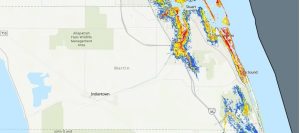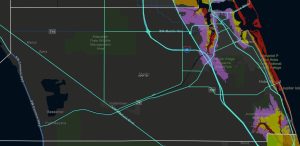As we enter the period when our Florida hurricane season gets more active, the National Weather Service (NWS) has offered a series of webinars, sharing guidance and tools to help keep ourselves and our communities safe. I’m highlighting a few key takeaways in this article and providing resources to explore further.
Think more “How do I prepare?”, less “What can I expect?”
Often with hurricanes, we focus on watching to see what we can expect, holding off on preparations until we know more about what the storm will do. I know I tend to do this, too, and it makes sense to a certain extent. However, knowing the devastation that hurricanes can cause and our level of risk as a peninsular state, it may be a good idea to approach storm preparation a little differently.
Know your risk and plan accordingly
Focusing on “what can I expect from the storm?” puts us in a place of waiting until a later date to get ready. While we have to weigh our risk against the effort spent preparing, there are ways we can be appropriately prepared and take early precautions without too much effort. By knowing more about our specific risks, we can prepare now, regardless of what each individual storm will bring. For example:

- Know your storm surge flood risk: Are you in an area where there is a risk of storm surge flooding? If not, then you know when those surge warnings come out, you don’t have to worry about taking more precautions. Storm surge flooding can extend further inland than you may expect, so don’t rule it out without checking! I was surprised to find how close the 1-foot and 3-foot storm surge areas are to where I live. And remember that storm surge may affect your evacuation route as well, even if it doesn’t affect your home or business. For example, portions of US Highway 1 near the north fork of the St. Lucie River are at risk of 3 feet or more of storm surge.
- Know your evacuation zone: You may already know your zone, but if you don’t, it’s quick and easy to find out and make a note of it.

Evacuation Zone Map for Martin County, FL as of August 1, 2024. Source: https://www.floridadisaster.org/knowyourzone - Gather disaster supplies: Tornadoes and thunderstorms extend out well beyond the hurricane force winds, and they can bring power outages, winds, and flooding rains. Having flashlights, batteries, and the like on hand will prepare us for any storm. Many of these items we already have stored at home. We just need to make sure they’re accessible and purchase any missing pieces. The disaster supply kit we prepare now will be with us through the rest of the season and beyond, only requiring periodic re-stocking of specific items needed.
Connect with your family, friends, and neighbors
- Could you offer a place of refuge for family or friends who live in areas affected by storm surge or evacuations? If you’re in an evacuation or surge risk zone, do you have friends or family nearby who could be a refuge for you and your family?
- The experience of storms and the emotional toll of another uncertain hurricane season can be draining. Talking with friends, family, and neighbors about shared experiences helps us all feel connected and supported.
The above are highlights and key pieces of the abundant resources available to us in preparing for storms. I hope they help you and your family and community to stay safe this hurricane season and into the future.
Resources for more information
NWS Florida Tropical Training week – recorded presentations and resources
NWS Hurricane Tracking Tools – hurricane and tropical storm watches, warnings, advisories and more
Ready.gov Hurricanes – hurricane preparation and recovery guidance
UF Disaster Preparation and Recovery – includes USDA guides for agricultural producers
 1
1
